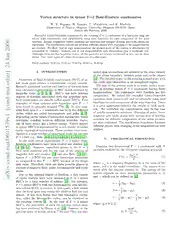
On Consistent Boundary Conditions for c=1 String Theory PDF
Preview On Consistent Boundary Conditions for c=1 String Theory
EFI-95-03 hep-th/9501039 On Consistent Boundary Conditions for c = 1 String Theory 5 9 9 1 n a Martin O’Loughlin J 3 Enrico Fermi Institute 1 University of Chicago 1 v 5640 S. Ellis Ave. 9 3 Chicago, IL 60637 USA 0 1 mjol@yukawa.uchicago.edu 0 5 9 / h WeintroduceanewparametrisationfortheFermiseaofthec = 1matrixmodel. Thisleads t - p to a simple derivation of the scattering matrix, and a calculation of boundary corrections e in the corresponding 1 + 1–dimensional string theory. The new parametrisation involves h : v relativistic chiral fields, rather than the non-relativistic fields of the usual formulations. i X The calculation of the boundary corrections, following recent work of Polchinski, allows r a us to place restrictions on the boundary conditions in the matrix model. We provide a consistent set of boundary conditions, but believe that they need to be supplemented by some more subtle relationshipbetween the space-time and matrix model. Inspired by these boundary conditions, some thoughts on the black hole in c = 1 string theory are presented. January 1995 1. Introduction One of the current outstanding problems in theoretical physics is the detailed under- standing of quantum processes that involve black holes. It is intriguing that we have a potential laboratory for studying these processes, the c = 1 matrix model, but frustrating that since the discovery of this model no significant progress has been made in studying its black hole physics. We present here an alternative picture, to those generally discussed [1], of the re- lationship between the free fermions of the matrix model and the space-time tachyon of two-dimensional string theory. As the fields we use to describe the matrix model are relativistic they provide a more direct relationship between the matrix model and the rel- ativistic spacetime physics. In spirit, our parametrisation is closest to that discussed in [2]. We rely for our intuition on the transform between the matrix model and the string theory recently discussed by Polchinski and Natsuume [3]1. 2. Fermi Sea in Light Cone Co-ordinates The fermions of the c = 1 matrix model arise from diagonalising the matrix of the matrix model, taking a large N (dimension of the matrix) limit and finding the critical scaling of coupling with N such that in this limit the Feynman diagrams of the matrix model can be thought of as smooth Riemann surfaces of differing genus. This continuum limitcan be described by the scattering problem for non-relativisticfermions in aninverted harmonic oscillator potential. dλ S = 1 (λ˙2 λ2)dx, λ˙ = (2.1) 2 Z − dx The standard approach to this theory, at the classical level, is to look at the low energy excitations of the fermi sea. These bosonic excitations, the collective field, lead to a non-linear relationship between left and right moving excitations - the classical S-matrix. We will follow a similar approach, but the collective fields we will use are different as we will now describe. 1 This transformation is motivated by comparing calculations in [4,5] and [6], but the explicit mapping between field equations in the matrix model and in the string theory was not discussed until the above mentioned paper by Polchinski and Natsuume. 1 p - + X X + ψ λ − ψ Fig. 1: Co-ordinate systems used throughout the paper and conventions for ingoing and outgoing fermion wavefunctions. Curved arrows show Hamilto- nian flow on phase space. ˙ With λ = p let X = p λ, (see fig. 1 for our conventions). The classical equation ± ± of motion is p˙ = λ and the general solution is X = a (σ)e t. For comparison with the ± ± ± parametrisation of the Fermi sea in terms of p (σ,t) [5], we will present a simple derivation ± of the classical S-matrix for low energy scattering. Assuming the ingoing disturbance of the Fermi sea never crosses the potential barrier, (which is sufficient for this classical calculation), we can write, a (σ) = a(σ)e b(σ) = a(σ)e σ, and h (σ) = log a(σ) σ. ± ± ± ± ± ± ± For Fermi seas which obey the restriction that X+(X ) is monotonic, h (σ) are − ± invertible. Then χ (X ,t) ( p2 +λ2 µ) ∓ ± ≡ − − = (a2(σ) µ) (2.2) − = a2(h 1(x t)) µ − ∓ ± − ∓ where x = log( X ). So we see that χ(v) are chiral fields, and one can show that they ± ± ∓ trivially satisfy χ (h (v)) = χ (h (v)). With a little more work one can also show that + + − − χ (w) = χ ( w + log( µ + χ (w))). This is the functional relationship between the + + − − − ingoing and outgoing collective field that leads to the classical S–matrix of Polchinski and of Moore and Plesser[4]. Putting, dω 1 χ = ∂ S¯ (u ) = ∞ α¯ (ω)eiωu∓, (2.3) ∓ ± ∓ ± Z 2π √2 ± −∞ 2 the recursive functional relationship between χ leads to a non-linear relationship between ± the modes α¯ which is the tree level collective field S–matrix. ± Ifα arethecreationandannihilationoperatorsforthe1+1–tachyon, thencomparing ± the calculations of Kutasov and DiFrancesco to the tree level collective field S–matrix [4,5], the appropriate relationship between α and α¯ is ± ± π Γ( iω) iω α¯ (ω) = α (ω)( )∓ 4 ∓ , (2.4) ± ± 2 Γ( iω) ± and combining this transformation with the collective field S–matrix gives the classical tachyon S–matrix. Another attractive feature of this decomposition of the Fermi sea excitations is that there is no breakdown of the collective field due to formation of folded configurations as the sea evolves in time [7] which in the extreme case involves pulses propagating over the barrier. To see the conservationof folds, define a foldbe a placeat which the collectivefield can no longer be well defined (it may become multiple valued). In our variables, this would appear as a turning point in X (σ,t)e t, as a function of σ. As these two functions are ∓ ± functions of σ only, the number of folds is encoded in a(σ) alone and is clearly conserved. 3. Canonical transformations of the Fermi Sea Even though this “light cone” description of the collective excitations of the Fermi sea is very simple as described in the previous section, to calculate higher order corrections to this picture it is by far most convenient to go back to the free fermion picture of the c = 1 matrix model. In this picture the description of scattering is obtained by a combination of fermionisation, free-fermi scattering and bosonisation [8]. The Feynman rules for the free fermi scattering consist of a wall vertex given by the non-relativistic reflection coefficient R(x), and a free fermi propogator. Higher loop corrections are given by sums of ring diagrams and are discussed in detail in [8]. The same calculations may be carried out here, but first we consider a simple method to derive the scattering coefficient R(x), the canonical transformation that relates ψ + to ψ (the ingoing and outgoing fermion wavefunctions). Again this is a globally defined − transformationand thus we do not have to lookat asymptoticstowork out the relationship between the wall scattering and the relativistic fields at infinity (compare [4,5]). As the coordinates (X+,X ) are canonically conjugate, the non-relativisticwavefunc- − tions, ψ and ψ , are the Fourier transforms of each other, (this is exactly as happens in + − non-relativistic quantum mechanics where the Fourier transform relates the position and momentum representations of a wavefunction). 3 1 ψ (X+) = ∞ dX eiX+X−ψ (X ) (3.1) − + − − √2π Z −∞ The Schro¨dinger equationbecomes 1(X+X +X X+)ψ = (i∂ µ)ψ . The normal 4 − − ± t− ± ordering is the unique choice that ensures that both left and right moving wavefunctions are delta function normalisable. For ψ we find (i iX ∂ +µ)ψk(X ) = kψk(X ). The wavefunctions are, + 2 − − − + − + − ψ+k(X−) = ak(X−)−i(k−µ)−12θ(X−)+bk(−X−)−i(k−µ)−21θ(−X−) (3.2) and similarly for ψk(X+). − Applying the canonical transform to ψk(X ) we find + − ψk(X+) = √2Γπ((X12−+i)(12k−−iµ(k))−µ)(akeiπ2(12−i(k−µ)) +bke−iπ2(12−i(k−µ))) X+ > 0 (3.3) − √2πΓ((12X−+i()k12−−µi)(k)−µ)(ake−iπ2(12−i(k−µ)) +bkeiπ2(21−i(k−µ))) X+ < 0 − From these expressions we see that the reflection coefficient is given by Γ(1 i(k µ)) b R(k µ) = 2 − − (e−iπ2(21−i(k−µ)) + keiπ2(21−i(k−µ))) (3.4) − √2π ak The boundary conditions are parametrised by the choice of bk, (a = 0 for the scattering ak k 6 problems considered here). To relate these calculations to those with a boundary at a fixed value of λ, (as in [9,8]), let us consider in our framework the boundary conditions for which the left and right moving fermion wavefunctions have the same form. This amounts to requiring that a e iπ(1 ix) +b eiπ(1 ix) b k − 2 2− k 2 2− k = . (3.5) akeiπ2(12−ix) +bke−iπ2(21−ix) ak It is easy to show that this implies a = b . k k ± For the case with a = b we find k k 2 π R (x) = Γ(1 ix)cos( (1 ix)) (3.6) I+ rπ 2 − 2 2 − and when a = b k k − 2 π R (x) = i Γ(1 ix)sin( (1 ix)). (3.7) I− − rπ 2 − 2 2 − The second (odd) case, is identical (to a phase) to the result of [8] for a wall at λ = 0. 4 For later purposes we will also write down the reflection coefficient for the no wall scattering in terms of ψ . This means there is no incoming wave from the right hand side ± of the barrier, or in other words ψ = 0 for X < 0. Then + − 1 RII(x) = √2πΓ(12 −ix)e−iπ2(12−ix) (3.8) Notice that the relativistic free fermions that we are describing, can be exactly bosonised. In the language of [10] the S–matrix is related to a bosonisation of fermionic Bogoliubov transformations on the in and out states of the Fermi sea. In the discussion of [8], the relativisticbosons that arise are found in the asymptotic behaviour of the collective field. In our description the bosons are everywhere relativistic. In the fermion field theory the S-matrix may be modified by choosing different in and out vacua around which one considers scattering. It would be intriguing to find some relationship between such choices of vacuum states for the fermions, choices of vacua for the bosons, and thus possibly to vacuum states for quantum fields in flat or curved spacetimes. From quantum field theory in curved space–times, we know that understanding vacuum states of the field involves understanding the relationship between wavefunctions in different asymptotic regions. It is thus necessary for us to understand the relationship between asymptotic regions in the matrix model and in the space–time. We will say a little more about this at the end of the next section, after we have discussed consistency of boundary conditions in the matrix model. 4. Low energy string theory We can now easily write down the expression for the full quantum 1 n amplitudes → of the matrix model collective field with general boundary conditions. One inserts the appropriate reflection coefficient as computed in the previous section, in the formulae derived in [8]. For example, the expression for the 1 2 amplitude is → ω ω 1 √3µ iωS(ω;ω ,ω ) = ( )dx R(x µ)R(µ+ω x) − 1 2 Z0 −Zω − − (4.1) 2 f (ω,ω ) µ 1 ≡ We can use f (ω,ω ), adapting a calculation of Polchinski and Natsuume [3], to derive µ 1 thesecondordercorrectiontotheoutgoingfieldintermsoftheingoingfield. Wewillsketch the outline, (the full details are well explained in [3]). 5 dω 1 Γ( iω)Γ( iω )Γ( i(ω ω )) S(2)(x+) = ∞ dω f (ω,ω )eiωx+ − − 1 − − 1 1 µ 1 − Z 2π √2iω Z Γ(iω) Γ(iω1) Γ(i(ω ω1)) −∞ − √2iω1Z dx−1 e−iω1x−1 S+(x−1 )√2i(ω −ω1)Z dx−2 e−i(ω−ω1)x−2 S+(x−2 ) (4.2) ex+ = π2√2 Z dx−1 dx−2 S+(x−1 )S+(x−2 )Z dω1 fµ(−i,ω1)e−iω1(x−1 −x−2 )−x−2 Here x = t φ, where (t,φ) are the string target space co-ordinates. The second equality ± ± was obtained from the first by considering the limit as x+ which is dominated by → −∞ the first pole of the integrand in the lower half plane. The leading order of perturbation theory in 1/µ at ω = i, gives us f = 1 . The integral over ω leads to a delta function − µ 2π 1 in x x giving the tree level correction, −1 − −2 ex+ S(2)tree(x+) = dx S (x )2e x−. (4.3) − + − − − 2π2√2 Z Onecanshowthattheseexpressionsarethesameasonederivesfromlowenergystring theory in the limit that x+ , (again we refer the reader to [3] for more details). In → −∞ string theory at x+ we are actually calculating in a weak tachyon perturbation → −∞ theory, and not a large µ expansion as one does in the matrix model. One can see this by noticing that the expansion parameter in (4.3)is e2φ∂ S. For early enough times this x quantity is always small regardless of the size of µ. Therefore there is potentially some mixing of the non–perturbative physics of the matrix model, (where the perturbation theory is in terms of 1/µ), with the perturbative physics of the low energy string theory. Such would be a direct result of the non–local nature of the transformation between these two theories arising from the Γ/Γ transforma- tion on the α(ω) (2.4), (a Hankel transform in position space). For example, a Gaussian tachyon pulse maps to a collective field excitation that has a decaying exponential early time behaviour, S¯(x ) ex−[3]. In the collective field of the matrix model, this means − ∼ that part of this ingoing excitation of the fermi sea spends an exponentially long time near the quadratic turning point, (even though the bulk of the pulse is centered on x x ). − 0 → Thus the non–perturbative tunneling rate is enhanced. Such enhancement can cause cor- rections to thelow energy effective actioninthe string theory. We now proceed to calculate these corrections. 6 4.1. Non-perturbative corrections to low-energy string theory. We will evaluate ex+ S−(x+) = π√2 Z dx−1 dx−2 S+(x−1 )S+(x−2 )Z dω1fµ(−i,ω1)e−iω1∆−x−2 (4.4) where Im ω = 1 and ∆ = x x . 1 −2 −1 − −2 Notice that for R (3.8)and R (3.6), the integrand in f ( i,x) has a double pole at II I+ µ − x = µ i, which is a point through which the ω integration contour is required to pass. − 2 1 To investigate the effect of this we deform slightly away from ω = i to ω = i+iǫ. The − − double pole is now a pair of poles at x = µ i and x = µ i + iǫ. Possible subtleties − 2 − 2 can now be anticipated to arise from the choice of integration for the two contours that appear in f . For the region of the ω integral near the poles, (the part of the ω integral µ 1 1 near ω = 0 is already accounted for and gave rise to (4.3)) 1 Z dω1fµ(−i,ω1)e−iω1∆−x−2 = Z dω1e−iω1∆(Z ω1 −Z −i−ω1)(x µ+ i)(xdx µ+ i iǫ) 0 −i − 2 − 2 − (4.5) and concentrating on the first term ω1 dx Z dω1e−iω1∆Z (x µ+ i)(x µ+ i iǫ) 0 − 2 − 2 − = e−iµ∆−∆2 Z ∞ dνe−iν∆Z ν−2i+µ (x µ+ i)(xdx µ+ i iǫ) −∞ 0 − 2 − 2 − (4.6) ǫ ie−iµ∆−∆2 ( ∞ dνe−iν∆ 2 dy ∼ Z Z (ν +iy)(ν +iy iǫ) κ −∞ − 2π ∞dνe iν∆) − − ǫ Z 0 The approximation in the second line of this expression is obtained by restricting the x integration to the region near the poles. The additional term that appears in the last line of (4.6) arises from pinching the dx contours as ǫ 0. When ω > µ i and ω < µ i → 1 − 2 1 − − 2 the contours are pinched between the two poles. = + Fig. 2: Deformationofthexintegrationcontouraroundthepoleatµ i+iǫ −2 for ω > µ i. 1 − 2 7 The deformation of the contour required to navigate the poles for (4.6) is shown in fig. 2. By similar manipulations we find for the second term, ǫ ieiµ∆−∆2 ( ∞ dνeiν∆ 2 dy 2π ∞dνeiν∆). (4.7) Z Z (ν +iy)(ν +iy iǫ) − ǫ Z κ 0 −∞ − − We used the choice for all contours that one obtains by taking the integrals along the real axis and continuously deforming them into the lower half plane as ω i. → − For this choice the final result has two terms on the right hand side that are important for the early time low energy string scattering. One term is that in (4.3) and agrees with the low energy string theory. The other, which comes from the residues of the pole shown in the first term on the right hand side of fig. 2, and a similar pole from the other part of the integral, is manifestly in disagreement with the low-energy string theory. It is, δS−(2)(x+) = 2ǫπ Z dx−1 dx−2 S+(1)(x−1 )S+(1)(x−2 )sin∆µ∆e−12(x−1 +x−2 ), (4.8) where we still need to take the limit as ǫ 0. This enables us to rule out this set of → boundary conditions. Onemaytryalternative,thoughlessnatural, prescriptionsforthepathsofintegration, and though one may remove the 1 divergence, one cannot remove an additional finite non- ǫ local correction to the correct second order low energy string theory. Of our three reflection coefficients R ,R ,R , only R is free from corrections in I+ I II I − − the second order calculation, coming from double poles as discussed above. However, for ω = 3i, which appears at higher orders in the weak field perturbation theory, one also − finds double poles in R (x)R (ω x), which the integration contour must negotiate. I I − − − These will contribute again to the perturbation theory in a manner not in agreement with the known behaviour of the low-energy string theory2, so R must also be ruled I − inconsistent. Wehavenotdiscussed otherchoices fora /b , orotherlocationsofthewallinR(x,A). k k In both cases the pole structure is more complicated than in the simple symmetric cases we have discussed, and in general are probably more problematic. For example, in the A → ∞ limit of R(x,A) the poles in the lower half plane accumulate along the real axis. This will 2 Although the tangle of contours that one needs to sort out is greater for ω = −3i. We have calculatedcorrectionsforω = −2i,similartothosediscussedabove, intheperturbationexpansion of S−(3). Then only RII has double poles that produce inconsistencies and RI± have single poles i at ω = µ− that are potentially problematic. For ω = −3i, RI± and RII have several poles that 2 will potentially produce additional corrections to the low energy string theory. 8 cause corrections to the above calculations in the first step, where one takes x+ , → −∞ as the first pole that one encounters in the lower half plane will not be at ω = i but at − Im ω > 1. − AstheproblemsarisefromthepolesinR(x)forImx < 0,wemayattempttoeliminate them by simply requiring boundary conditions for which no such poles appear in the lower half plane. Referring to (3.4), we see that this requires abkk = −eiπ(12−i(k−µ)),which gives, 2 RNS(x) = −irπΓ(21 −ix) sinπ(21 −ix)eiπ2(21−ix). (4.9) We didnot writedown this reflection coefficient inour discussion of boundary conditions in section 3, as we wanted some symmetry between the ingoing and outgoing wavefunctions. For this R(x) we find that ψ (x+) = 0 for X+ > 0. Using these boundary conditions is − probably not the solution for which we are searching, due to the lack of symmetry between ingoing and outgoing wavefunctions. It is amusing to note that this is closely related to the no wall scattering coefficient (3.8) for which ψ (x ) = 0 for X < 0. Furthermore, + − − R (x) appears as the behaviour of R (x,A), as A at Im x < 0 [8] (for Im NS I − → ∞ x > 0 R R ). This suggests that maybe some less local identification between I II − → matrix model phase space and space–time is required for a consistent low–energy string theory. Similar suggestions were made in [11]. The most naive realization of this modified mapping would be to use R for ingoing II fermions, and R for the outgoing fermions, or vice versa, in the formulae of [8]. This NS will cause problems in the low energy string theory as one may verify by calculating, similarly to the above, the contribution from the logarithmic branch cut in f ( i,ω ), µ 1 − at ω = µ i, (the source of the contribution is again the residue of the pole that 1 − 2 needs to be included due to the deformation of the x integration contour by the pole). Another resolution would simply be to use lim R (x,A) = R (x). R (x) is singular A I I′I I′I →∞ − only in the sense that it is discontinuous across its branch cut along the real axis. More significant than potential complications arising from this branch cut, is the similarity between these reflection coefficients and choices for bases of wavefunctions of quantum fields in the presence of black holes. In such a case one may consider in states that involve no component crossing the past horizon (compare in R with ψ (X ) = 0 for X < 0), II + − − and out states that involve no component crossing the future horizon (compare in R NS with ψ (X+) = 0 for X+ > 0) 3. Taking this idea seriously suggests that we should find − Hawking radiation in the quantum tunneling through the inverted harmonic oscillator, enhanced by the Hankel transform that relates the matrix model and string theory [13]. 3 See for example [12], where a natural basis of vertex operators consists of {Uωλ,Vωλ} where λ λ Uω vanish on the past horizon and Vω vanish on the future horizon. 9
The list of books you might like

Believe Me

Do Epic Shit

The Spanish Love Deception

Shatter Me Complete Collection (Shatter Me; Destroy Me; Unravel Me; Fracture Me; Ignite Me)

Right off the Bat by William F Kirk

Excess conductance of a spin-filtering quantum dot

Diagnosing Energy Loss: PHENIX Results on High-pT Hadron Spectra

Corrections to scaling in multicomponent polymer solutions

TS 125 323 - V6.4.0 - Universal Mobile Telecommunications System (UMTS); Packet Data Convergence Protocol (PDCP) specification (3GPP TS 25.323 version 6.4.0 Release 6)

Random-energy model in random fields

c

Large mass enhancement in RbOs2O6

Corso sulla storia della chiesa di roma

Vortex structure in spinor F=2 Bose-Einstein condensates

Luck on the Wing by Elmer Haslett
![SL(n,Z[t]) is not FP_{n-1} book image](https://cdn.pdfdrive.to/media/content/thumbnails/d5139d6f-df0f-47ff-a92e-7a36e43ce044.webp)
SL(n,Z[t]) is not FP_{n-1}

Catesbeiana : bulletin of the Virginia Herpetological Society

Greek Government Gazette: Part 2, 1993 no. 437

Montala

Satjug 2062 2006




